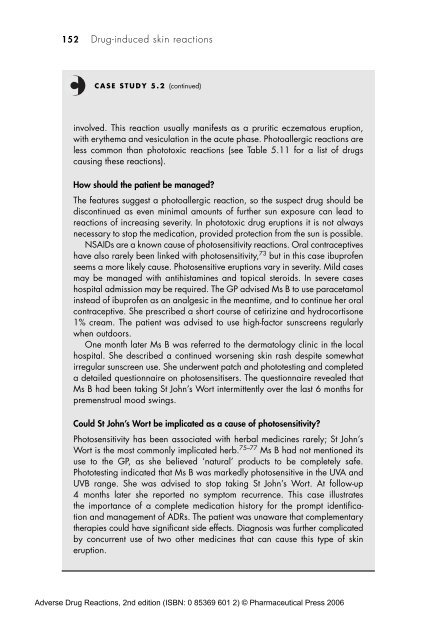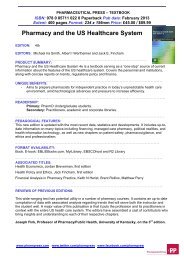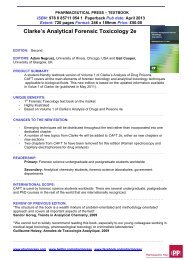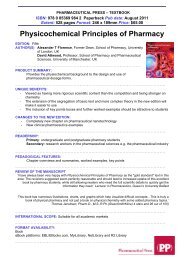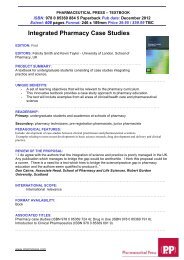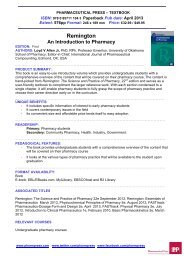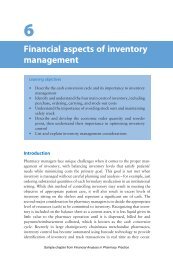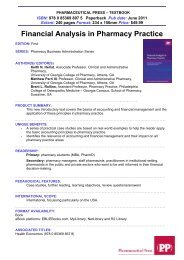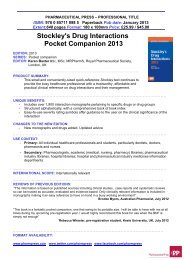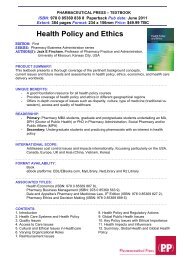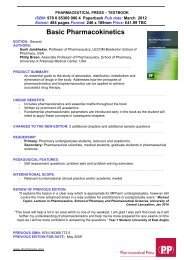Drug-induced skin reactions - Pharmaceutical Press
Drug-induced skin reactions - Pharmaceutical Press
Drug-induced skin reactions - Pharmaceutical Press
You also want an ePaper? Increase the reach of your titles
YUMPU automatically turns print PDFs into web optimized ePapers that Google loves.
152 <strong>Drug</strong>-<strong>induced</strong> <strong>skin</strong> <strong>reactions</strong><br />
CASE STUDY 5.2 (continued)<br />
involved. This reaction usually manifests as a pruritic eczematous eruption,<br />
with erythema and vesiculation in the acute phase. Photoallergic <strong>reactions</strong> are<br />
less common than phototoxic <strong>reactions</strong> (see Table 5.11 for a list of drugs<br />
causing these <strong>reactions</strong>).<br />
How should the patient be managed?<br />
The features suggest a photoallergic reaction, so the suspect drug should be<br />
discontinued as even minimal amounts of further sun exposure can lead to<br />
<strong>reactions</strong> of increasing severity. In phototoxic drug eruptions it is not always<br />
necessary to stop the medication, provided protection from the sun is possible.<br />
NSAIDs are a known cause of photosensitivity <strong>reactions</strong>. Oral contraceptives<br />
have also rarely been linked with photosensitivity, 73 but in this case ibuprofen<br />
seems a more likely cause. Photosensitive eruptions vary in severity. Mild cases<br />
may be managed with antihistamines and topical steroids. In severe cases<br />
hospital admission may be required. The GP advised Ms B to use paracetamol<br />
instead of ibuprofen as an analgesic in the meantime, and to continue her oral<br />
contraceptive. She prescribed a short course of cetirizine and hydrocortisone<br />
1% cream. The patient was advised to use high-factor sunscreens regularly<br />
when outdoors.<br />
One month later Ms B was referred to the dermatology clinic in the local<br />
hospital. She described a continued worsening <strong>skin</strong> rash despite somewhat<br />
irregular sunscreen use. She underwent patch and phototesting and completed<br />
a detailed questionnaire on photosensitisers. The questionnaire revealed that<br />
Ms B had been taking St John’s Wort intermittently over the last 6 months for<br />
premenstrual mood swings.<br />
Could St John’s Wort be implicated as a cause of photosensitivity?<br />
Photosensitivity has been associated with herbal medicines rarely; St John’s<br />
Wort is the most commonly implicated herb. 75–77 Ms B had not mentioned its<br />
use to the GP, as she believed ‘natural’ products to be completely safe.<br />
Phototesting indicated that Ms B was markedly photosensitive in the UVA and<br />
UVB range. She was advised to stop taking St John’s Wort. At follow-up<br />
4 months later she reported no symptom recurrence. This case illustrates<br />
the importance of a complete medication history for the prompt identification<br />
and management of ADRs. The patient was unaware that complementary<br />
therapies could have significant side effects. Diagnosis was further complicated<br />
by concurrent use of two other medicines that can cause this type of <strong>skin</strong><br />
eruption.<br />
Adverse <strong>Drug</strong> Reactions, 2nd edition (ISBN: 0 85369 601 2) © <strong>Pharmaceutical</strong> <strong>Press</strong> 2006


